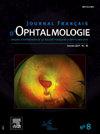Early results of allograft intrastromal ring segment for keratoconus
IF 1.2
4区 医学
Q3 OPHTHALMOLOGY
引用次数: 0
Abstract
Purpose
This study aimed to determine the efficacy of a novel nomogram for implanting allograft intrastromal ring segments in keratoconus patients.
Materials and methods
The study included 86 eyes of 86 patients who were followed for 6 months. Patients were treated using the Istanbul nomogram, which is used to guide the creation of corneal tunnels, utilizing a femtosecond laser, with dimensions of 4 × 7.5 mm and a depth of 200 μm. Sterile allograft corneal rings (KeraNatural™) were implanted at the precise location of the cone. Pre- and postoperative measurements of SE, CDVA, UDVA, keratometry values, and topographic map parameters were compared. Additionally, an online protractor was used to measure the angle of the cone and the angle of the implanted allograft ring.
Results
After surgery, there was significant improvement in SE, CDVA, UCVA, keratometry values, and topographic map parameters, including anterior map elevation (AME), posterior map elevation (PME), and best-fit sphere (BFS) anterior and posterior (P < 0.001). In addition, a statistically significant correlation was found between the cone angle and KeraNatural™ length (P < 0.001).
Conclusion
Our findings highlight the importance of considering the cone angle and KeraNatural™ length in preoperative evaluations. These parameters might help predict potential visual acuity outcomes and tailor surgical plans according to individual patient needs. The stability of most visual parameters over six months reaffirms the long-term efficacy of surgical interventions. The KeraNatural™ used in this study is safe and effective in keratoconus patients and provides an opportunity to avoid keratoplasty.
Objectif
Cette étude visait à déterminer l’efficacité d’un nouveau nomogramme pour les segments d’anneaux intrastromaux d’allogreffe lors de l’implantation d’une allogreffe intrastromale chez des patients atteints de kératocône.
Matériaux et méthodes
L’étude a inclus 86 yeux de 86 patients suivis pendant 6 mois. Les patients ont été traités en utilisant le nomogramme d’Istanbul, qui guide la création des tunnels cornéens en utilisant un laser femtoseconde avec des dimensions de 4 × 7,5 mm et une profondeur de 200 μm. Des anneaux cornéens stériles d’allogreffe (KeraNatural™) ont été implantés à l’emplacement précis du cône. Les mesures pré- et postopératoires de la SE, CDVA, UDVA, des valeurs de kératométrie et des paramètres de la carte topographique, ont été comparées. De plus, un rapporteur en ligne a été utilisé pour mesurer l’angle du cône et l’angle de l’anneau d’allogreffe implanté.
Résultats
Après la chirurgie, on a observé une amélioration significative de la SE, de la CDVA, de l’UCVA, des valeurs de kératométrie et des paramètres de la carte topographique, y compris l’élévation de la carte antérieure (AME), l’élévation de la carte postérieure (PME) et la sphère d’ajustement optimale (BFS) antérieure et postérieure (p < 0,001). De plus, une corrélation statistiquement significative a été trouvée entre l’angle du cône et la longueur de KeraNatural™ (p < 0,001).
Conclusion
Nos résultats soulignent l’importance de prendre en compte l’angle du cône et la longueur de KeraNatural™ lors des évaluations préopératoires. Ces paramètres pourraient aider à prédire les résultats potentiels de l’acuité visuelle et à personnaliser les plans chirurgicaux en fonction des besoins individuels des patients. La stabilité de la plupart des paramètres visuels sur six mois confirme l’efficacité à long terme des interventions chirurgicales. Le KeraNatural™ utilisé dans cette étude est sûr et efficace chez les patients atteints de kératocône et offre la possibilité d’éviter une kératoplastie.
同种异体角膜间环段移植治疗圆锥角膜的早期结果
目的探讨一种新的形态学方法在圆锥角膜移植中的应用效果。材料与方法对86例患者86只眼进行为期6个月的随访。患者使用伊斯坦布尔图进行治疗,该图利用飞秒激光引导角膜隧道的形成,尺寸为4 × 7.5 mm,深度为200 μm。无菌异体角膜移植环(kerannatural™)被植入角膜锥的精确位置。比较术前和术后测量的SE、CDVA、UDVA、角膜测量值和地形图参数。此外,还使用在线量角器测量移植体锥体的角度和移植体环的角度。结果术后患者SE、CDVA、UCVA、角膜测量值及地形图参数,包括前路地形图抬高(AME)、后路地形图抬高(PME)、最佳拟合球(BFS)前后路(P <;0.001)。此外,锥角与kerannatural™长度(P <;0.001)。结论我们的研究结果强调了在术前评估中考虑椎体角度和KeraNatural™长度的重要性。这些参数可能有助于预测潜在的视力结果,并根据个别患者的需要定制手术计划。大多数视力参数在6个月以上的稳定性再次证实了手术干预的长期疗效。本研究中使用的kerannatural™对圆锥角膜患者安全有效,并提供了避免角膜移植术的机会。ObjectifCette练习曲visait限定词l 'efficacite d一个新nomogramme倒les段d 'anneaux intrastromaux d 'allogreffe当时de l 'implantation一allogreffe intrastromale atteints de keratocone在des病人。matsiriaux et msamthodl ' samodys a包括86名患者,86名患者的生存状况。激光飞秒直径直径为4 × 7.5 mm,直径为200 μm。激光飞秒直径直径为4 × 7.5 mm。Des anneaux cornsamens stacriiles d 'allogreffe (kerannatural™)ont samuest implantsamuest samuest l 'emplacement pracimcis du cône。其他措施- - - - - - - - - - - - - - - - - - - - - - - - - - - - - - - - - - - - - - - - - - - - -另外,还有一种测量器,即测量器,测量角,测量角,测量角,测量角,测量角,测量角。ResultatsApres la chirurgie,观察一个改良有意义的de la, de la CDVA de l 'UCVA值de keratometrie et des产品de la署名topographique y理解l 'elevation菜单anterieure (AME), l 'elevation de la署名posterieure(中外)等拉球d 'ajustement optimale (BFS) anterieure et posterieure (p & lt;0001)。此外,一项具有重大意义的通讯统计数据表明:1 . * * * * * * * * * * * * * * * * * * * * * * * * * * *0001)。结论:未完成的和/或其他形式的和/或其他形式的和/或其他形式的和/或其他形式的和/或其他形式的和/或其他形式的和/或其他形式的和/或其他形式的和/或其他形式的和/或其他形式的和/或这些参数可以帮助改善个人和患者的健康状况,改善患者的健康状况,改善患者的健康状况,改善患者的健康状况,改善患者的健康状况。La stabilit de La plupart des paramtres visuels在6个月的时间里证实了长期干预手术的有效性。Le kerannatural™实用程序为患者提供了一种新的治疗方法,使患者在治疗过程中获得更好的治疗效果,使患者在治疗过程中获得更好的治疗效果。
本文章由计算机程序翻译,如有差异,请以英文原文为准。
求助全文
约1分钟内获得全文
求助全文
来源期刊
CiteScore
1.10
自引率
8.30%
发文量
317
审稿时长
49 days
期刊介绍:
The Journal français d''ophtalmologie, official publication of the French Society of Ophthalmology, serves the French Speaking Community by publishing excellent research articles, communications of the French Society of Ophthalmology, in-depth reviews, position papers, letters received by the editor and a rich image bank in each issue. The scientific quality is guaranteed through unbiased peer-review, and the journal is member of the Committee of Publication Ethics (COPE). The editors strongly discourage editorial misconduct and in particular if duplicative text from published sources is identified without proper citation, the submission will not be considered for peer review and returned to the authors or immediately rejected.

 求助内容:
求助内容: 应助结果提醒方式:
应助结果提醒方式:


